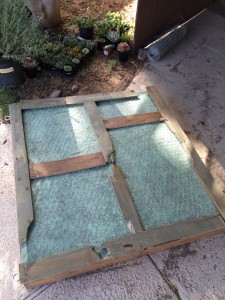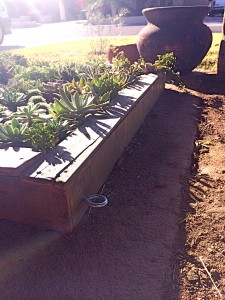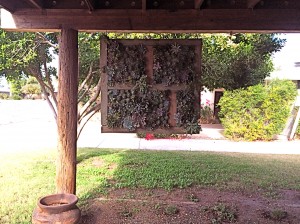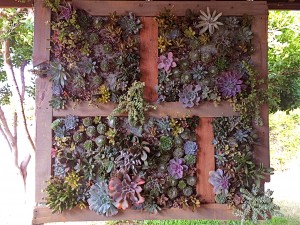When floor space is limited, a vertical planter allows you to introduce the air purifying, humidifying, aesthetic properties of live plants with the functionality of a hanging piece of art.
Supplies for structure:
- Wood slats from found pallets,
- section of particle board for backing (size of preferred planter),
- 1″ or 2″ galvanized chicken wire,
- landscaping fabric (I found some made out of recycled plastic bottles),
- and large galvanized eye-bolts for hanging the piece. (These differ in size based on the weight, be sure to check this when purchasing.)
- open eye-bolts for attaching piece to wall or beam (these also vary depending on weight).
Tools:
- staple gun,
- sawzall or saw of preference,
- hammer and power drill,
- hand-held electric sander
- galvanized nails,
- small trawl for soil,
- large bucket for mixing,
- wire cutters and a scissor
Soil Recipe:
- 2 parts cactus soil
- 1 part perlite for moisture retention and
- 1 part fine porous gravel or lava fines
Plants:
- succulents of choice (I used a variety of heights and species within mine to give an organic feel to the planter)
Instructions:
- decide how big you want your planter. My tip – start small. (The first one I made and the one showcased was made with a 4’x 4′ pallet and weighs upwards of 200lbs.)
- Sand all pieces and remove old nails from pallets. Reserve your most rustic pieces for the final frame or face of the planter box.
- Measure and cut your plywood backing and side and top beams creating the primary structure of your planter.
- Nail beams in place from back of planter.
- Using a drill bit slightly smaller than your eye hooks drill 2-3 holes depending on weight of planter and screw in eyes and twist on bolts to secure inside the planter.
- Stretch and staple chicken wire flush with plywood backing and side beams.
- Pour in soil. Be sure to fill to the brim since the planter will be hanging and you don’t want your soil to move.
- Stretch and staple landscaping fabric to outer beams. And follow with another layer of stretched chicken wire. This is layer that will hold in your succulents.
- Nail framing pieces to side beams covering the staples.
- Cover with waterproof sealant and allow to dry.

- Drill several drainage holes in bottom of planter. (I drilled some in the middle of mine as well since I divided my planter into 4 sections.)
- Using wire cutters select the wires to be bent back for insertion of plant. You will need to use the scissor to cut the landscaping fabric in that area as well. (I found that by clipping and bending back that it held the plants in place better, rather than cutting out the sections entirely. I could then bend the wire back down around the root to secure the plant.) *Also, remember that your plants will grow and spread, so you might want to allow for this.
- After planter is full, spritz heavily with water and allow to sit for 1-2 weeks to achieve a strong root system before hanging.

- Drill holes for open eye-bolts where you plan to hang your piece.
- Hang planter and enjoy! Water with spray bottle according to instructions for your particular species. Succulents don’t need to be watered a lot, but they enjoy a thorough soaking every two weeks or so. This should be increased if you are in dryer climates.


